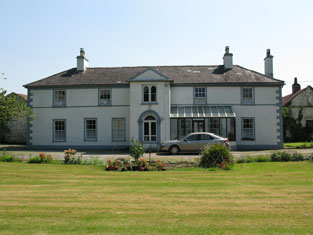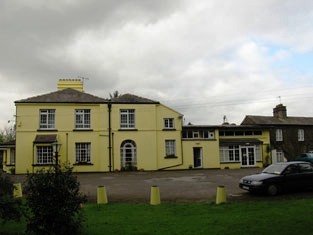Castle View
Houses within 5km of this house
Displaying 16 houses.
Houses within 5km of Castle View
Displaying 16 houses.
| House name | Description | |
|---|---|---|
| Raleigh | In 1837 Raleagh was the residence of W. Minhear. James Minhear was occupying this house in the mid 19th century. He held it from the representatives of - Carleton and it was valued at £20.10 shillings. | |
| Codrum | In 1837 Edward Ashe was occuping a house in the townland of Condrum and this house remained the residence of Edward Ashe until at least the 1870s. In the early 1850s it was valued at £18.15 shillings. It is labelled Codrum West on the 1st edition Ordnance Survey map and as Codrum on the later 25-inch edition of the 1890s. It is still extant. |

|
| Cooldaniel | This house was the home of Barter esq in the 1770s and 1780s, of Thomas Barter in 1814, of J. Barter in 1837 and of Michael Buckley at the time of Griffith's Valuation who held it from William Gallagy. It was valued at £10. In the 1940s the Irish Tourist Association Survey noted that it had been converted to farm buildings.. | |
| Ballytrasna | Located on the Earl of Bandon's estate, occupied by the Reverend B. Gash in 1837 and by Thomas Neville in the early 1850s when the house was valued at £10. The location of this house now appears to be under water. | |
| Codrum House | In the 1770s and 1780s Codrum was occupied by Hutchinson esq. It was the residence of John Warren in 1814. There were two houses in this townland at the time of Griffith's Valuation, one occupied by Richard Ashe and the other by Massy H. Warren. The Warren house was known as Codrum House. It was valued at £19. Frederick H. Warren was resident in the 1870s. In 1944 the Irish Tourist Association Survey referred to Codrum as the home of Mrs.S.W. Baldwin and also to the murder of Colonel Hutchinson there. The original house at this site is now a ruin. | |
| Elmglyn | Elmglyn was the residence of T. Gollock in 1837 and of Patrick Daly at the time of Griffith's Valuation. He held the property from the representatives of Thomas Gollock and the buildings were valued at £11. The original house is not extant. | |
| Mount Massy | This house was the residence of Hutchinson esq in the 1770s. Occupied by Hubert [Herbert?] Baldwin in 1814 and by M.H. Massey in 1837. Mount Massy appears to be in use as an auxiliary workhouse at the time of Griffith's Valuation, when the buildings were valued at £50. At the time of the sale in 1861 Mount Massy was in the owner's possession and was held under a fee farm grant from the Earl of Bandon, dated 2 Feb 1859. It was burnt in December 1920 during the War of Independence and is now a ruin. | |
| Firville | Leet lists a Robert McCarthy residing at a house called Fir-ville, Macroom in 1814. Lewis refers to Firville, the newly erected mansion of Philip Harding. Henry Harding was the occupier in the early 1850s holding the property from N.D. Murphy. It was valued at £19.10 shillings. The representatives of Henry Harding still owned Firville in the 1870s. Firville passed to the Barry family through the marriage of Ellen Harding, daughter of Henry Harding, and Thomas Barry, son of Michael Barry of Elm Park, Farran, county Cork, land agent to Sir Riggs Falkiner. In 1944 the Irish Tourist Association Survey noted that Firville was then the residence of F. St.Aubyn Horgan, who had connections with the Channel Islands. Firville is still extant and occupied. | |
| Coolcour/Coolcower | Home of the Browne family in the 18th and 19th centuries, occupied by John Browne in 1814, by W.G. Browne in 1837 and still his residence in the 1870s. In the early 1850s the house was valued at £46 and was held in fee. St George G. Browne was resident in 1906. Coolcour was burnt in July 1921, just before the end of the War of Independence, when it was the residence of Richard C. Williams, a hotel owner in Macroom. It was rebuilt and now functions as a guest house, see http://www.coolcowerhouse.ie/ |

|
| Coolyhane | Lewis refers to Coolehane as recently erected, Richard Ashe was proprietor. Richard Ashe was still the occupier in the early 1850s and held the property from Elizabeth Foote when it was valued at £15.15 shillings. In 1944 the Irish Tourist Association Survey noted that it had formerly belonged to the Ashe family but was then the home of Mr. Purcell, solicitor. It is still extant. | |
| Gurteenroe Cottage | A house valued at £10.15 shillings was occupied by James Welpy on the Hedges estates at Gurteenroe in the early 1850s. In the 1870s and 1880s the home of Charles Raycroft. It is still extant and well-maintained. |

|
| Mount Hedges | Mount Hedges, formerly a family residence, had by the time of Griffith's Valuation become the steward's house, valued at £15. In 1786 Wilson had referred to it as "the beautiful seat of Captain Robert Hedges". There are some ruins remaining at the site. | |
| Macroom Castle | In 1750 Charles Smith recorded Macroom Castle as the residence of Richard Hedges Eyre. Lewis wrote in 1837 that Macroom was "till very lately..the joint property of the Earl of Bandon and Robert Hedges Eyre" but was then the sole property of the latter, who had converted the ancient castle into an elegant modern mansion. Held by the Honourable William Henry White Hedges in fee at the time of Griffith's Valuation, when the buildings were valued at £80. Slater records it as being a seat of Lord Ardilaun in 1894. Macroom Castle was burnt in 1922. In 1944 the Irish Tourist Association Survey gathered a detailed history of the building, noting that "it was burnt in all about five times" in its long history. The impressive gateway is all that remains. |

|
| Rockborough | Rockborough was the home of T. Mitchel Browne in 1837. Situated on the Hedges estate it was occupied by John G. Browne in the early 1850s, when it was valued at £25. In 1944 the Irish Tourist Association Survey noted that it had formerly belonged to the Brownes but was then the home of the Twomey family. This property is still extant. | |
| Sandy Hill | Home of the Reverend John Orpin in 1814, by 1837 this house was the residence of Thomas S. Coppinger and remained a Coppinger home for the rest of the 19th century. Located on the Hedges White estate it was valued at £9 in the 1850s. In 1944 the Irish Tourist Association Survey reported that it was the residence of Timothy Lucey, solicitor. There is still an extant house at the site. | |
| Warren's Court | Kilbarry was bought by the Warrens in the late 17th century. The house Warren's Court was built in the 18th century and was the main seat of this family in the 18th and 19th centuries. In 1750 Smith refers to Kilbarry the "handsome house" of Robert Warren. Wilson notes it as "the fine seat of Thomas Warren" in 1786. In 1894 Slater refers to it as the seat of Sir A. Warren. In 1906 it was valued at £66 and occupied by Sir Augustus Riversdale Warren.. It was burnt in June 1921 during the War of Independence when it was the residence of Sir Augustus D. Warren. The original house is no longer extant. In the 1940s the Irish Tourist Association Survey reported that a modern two-storey house had been constructed nearby. |

